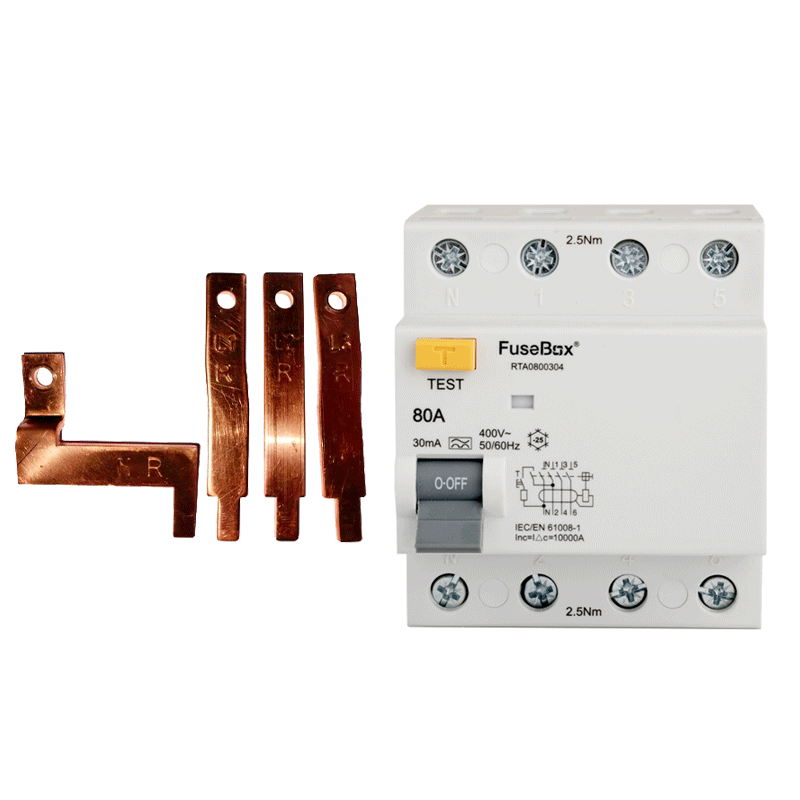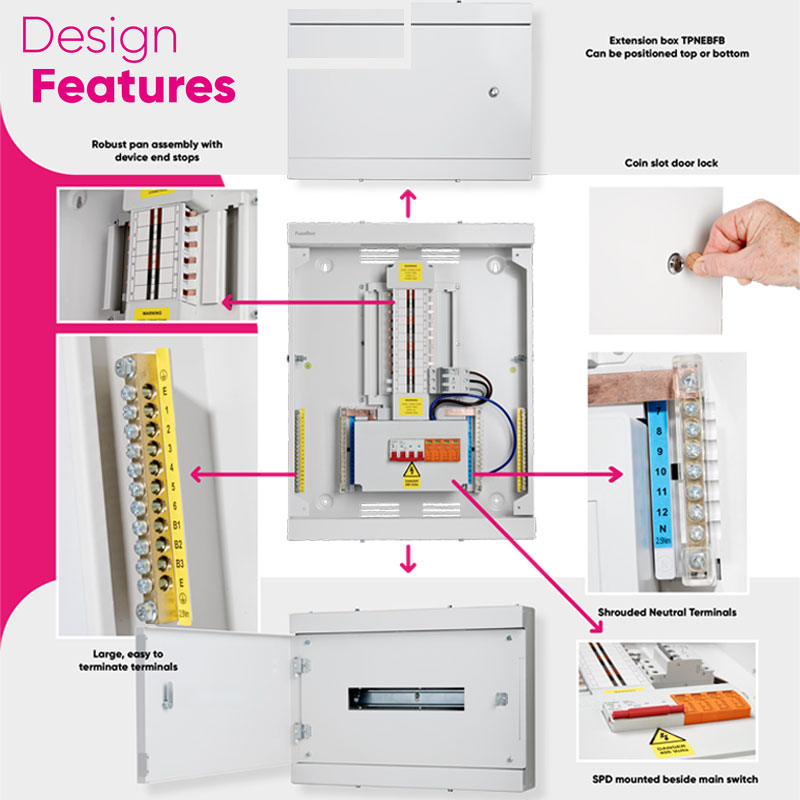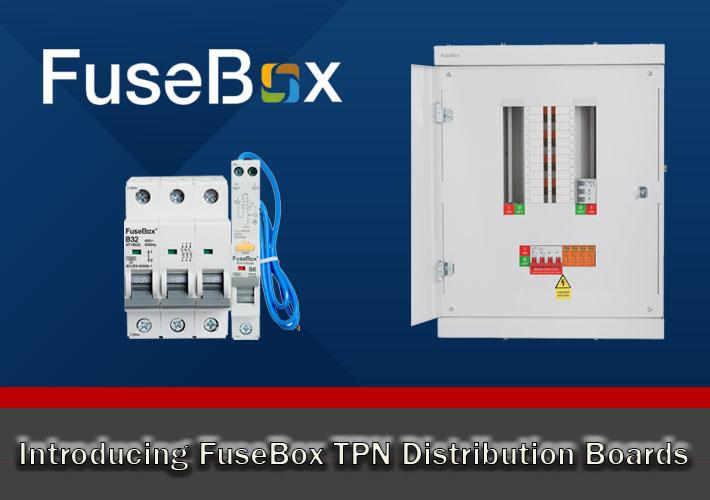Introducing FuseBox TPN Distribution Boards
The highly awaited FuseBox TPN (Triple Pole & Neutral) distribution boards are finally here, but they’re selling fast due to the high demand.
Available with or without surge protection, they come factory fitted with a 100A 4 pole main switch incomer as standard. The main switch or MS for short can be replaced with an RCD (Residual Circuit Device) to give you added RCD protection or you could use the MS with RCBOs and have each circuit individually RCD protected. This combination has been hugely popular in the single phase consumer unit range that FuseBox have pioneered for the past 5 years. RCBOs are only available in single pole versions, but three phase FuseBox RCBOs are expected in 2024.
If you're replacing the MS, with an RCD, there are options available in 63A, 80A and 100A. The 100A RCD is available in 30mA, 100mA and 300mA, the other current ratings are only available in 30mA. They're also available in Type A, Type B and S Type versions. You'll also need the RCD connector kit to complete the upgrade, shown below:

RCD Incomer with Connection Kit
These sturdy looking boards are available in 3 to 16 useable triple pole ways with a wide range of accessories. The surge protected boards are available with 3, 7, 11 and 15 useable ways and the non surge protected distribution boards are available in 4, 8, 12 and 16 useable ways. The surge protection device or SPD takes up some of the space. The FuseBox TPN brochure is available here.

Distribution board with SPD
Durable Construction
Constructed from durable 1.2mm galvanised steel, the distribution board enclosure is designed to withstand even the most challenging conditions. It's completed with a RAL 9001 epoxy powder finish for added longevity. Fitted with large, easy to wire terminals which helps to speed up installation times.


Non Surge Protected Board
Frequently Asked Questions
Do you have to use 10kA circuit breakers for TPN applications?
No you don’t! Circuit breakers with a 6kA breaking capacity may be suitable but 10kA ensures the ability to work even after it has cleared a fault current up to 10kA. The potential fault current of TPN installations should be calculated first. If in doubt we recommend using 10kA MCBs as the single pole versions only cost £1.39 more than the 6kA and FuseBox are only doing triple pole MCBs in 10kA, so you don’t really have a choice.
The same predicament also happens with RCBOs. FuseBox have introduced a dedicated range of 10Ka RCBOs which are available in B or C type tripping curves. While the 10kA option does cost around £6 more than the 10kA, they’re still a much more affordable option than current market leaders like Schneider and Hager.
What is Breaking Capacity?
The breaking capacity of a circuit breaker, often measured in kiloamperes (kA), signifies the maximum current that a circuit breaker can safely interrupt without failing or causing an electrical hazard. This is a critical parameter that indicates the breaker's ability to deal with fault conditions such as short-circuits.
In essence, the higher the breaking capacity, the more robust the circuit breaker is in terms of its capability to handle excessive currents. Manufacturers usually specify this value under standardised conditions, which often includes the maximum voltage the breaker can handle.
When selecting a circuit breaker for a particular application, it is crucial to ensure that the breaking capacity is higher than the prospective short-circuit current at that point in the electrical system. Failing to match the breaking capacity with the system's potential fault level can result in catastrophic failure and poses a serious safety risk.
Can I Use AFDD Circuit Breakers in TPN Boards?
Yes, but the FuseBox AFDDs (Arc Fault Detection Device) are only rated at 6kA. They can be used and fitted in a TPN board but only if the installation is rated at no greater than 6kA potential fault current.
The latest version of the IET Wiring Regulations, BS 7671:2018, advises the use of AFDDs, although their installation is not yet mandatory. Customers have the option to forgo them, but such a decision should weigh the safety risks and relevant hazards against the financial implications of installing the devices.

FuseBox AFDD
What’s the Cheapest 3 Phase Distribution Board?
The non surge protected boards are the most cost-effective option. They’re available in 4 to 16 TPN useable ways. FuseBox 3 phase distribution boards cost a little bit more than Schneider, but Schneider distribution boards don’t come with any incoming devices. Once you’ve added their TPN MS which is product code: SEA91253N you’ll have to add another £80 to your project costs.
The real savings come from the MCBs (Miniature Circuit Breakers), the FuseBox triple pole MCBs cost around £10 each and Schneider MCBs are around £55 each. A FuseBox 4 way distribution board with a 125A MS and 4 triple pole MCBs would cost you around £222 exc VAT, while a Schneider equivalent is going to set you back around £460; I know which brand I’d be specifying for my business! This is without considering the cost of RCBOs which are mega expensive from those other brands and only £18.63 from FuseBox.
Why Do I Need a Surge Protected Distribution Board?
A surge-protected distribution board is crucial for safeguarding electrical equipment in a three-phase system. Electrical surges, caused by factors like lightning or heavy load switching, can damage sensitive devices and even cause fires. Such incidents result in costly repairs and downtime. Moreover, surge protection at the distribution board centralises safety measures, making it more efficient than individual outlet protectors. Overall, a surge-protected distribution board enhances safety, reliability, and compliance.
Can I Fit Contactors & Timers in a 3 Phase Board?
Yes, but you the need the extension housing (TPNEBFB). This can be fitted on the top or bottom of the board and allows you to add component like the INC installation contactors and the TD1 time clock. It can be used to house any devices that can’t be connected into the TPN busbar.





